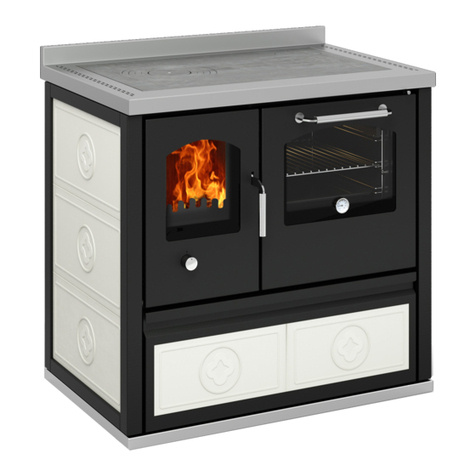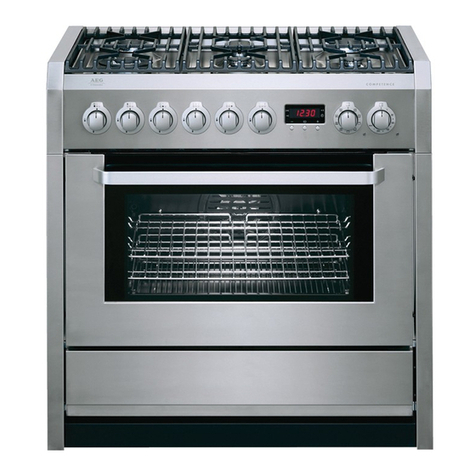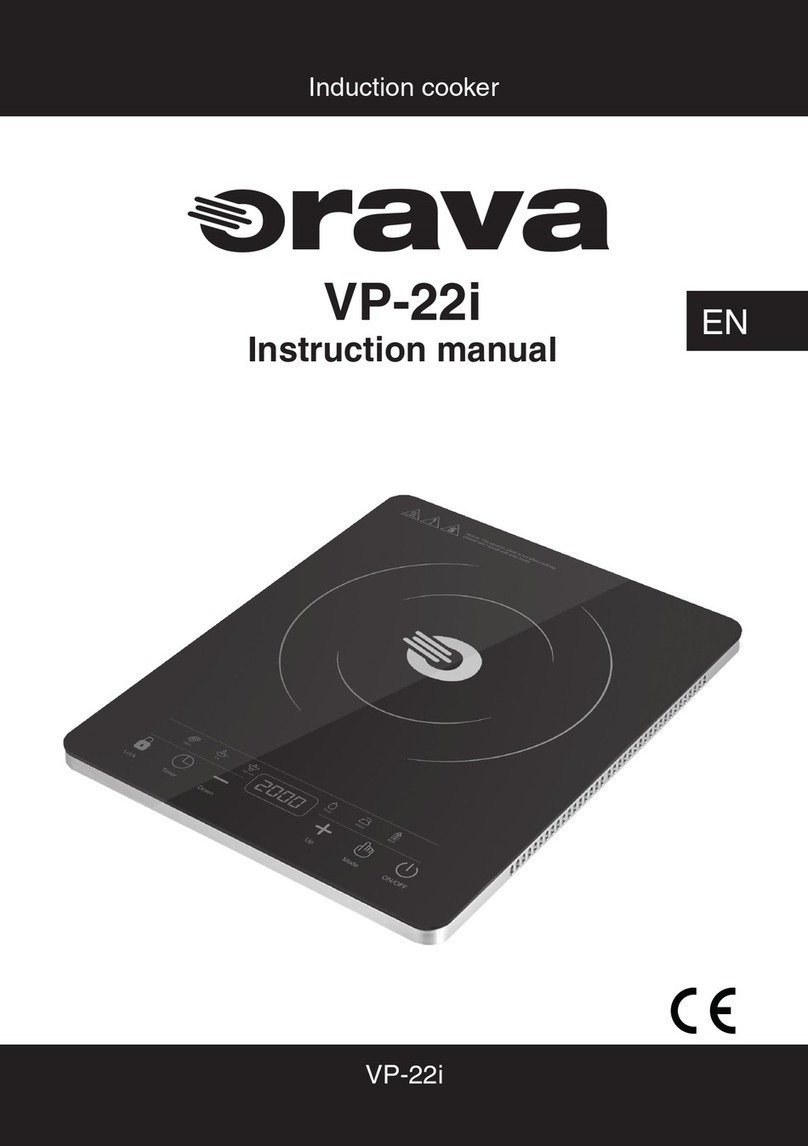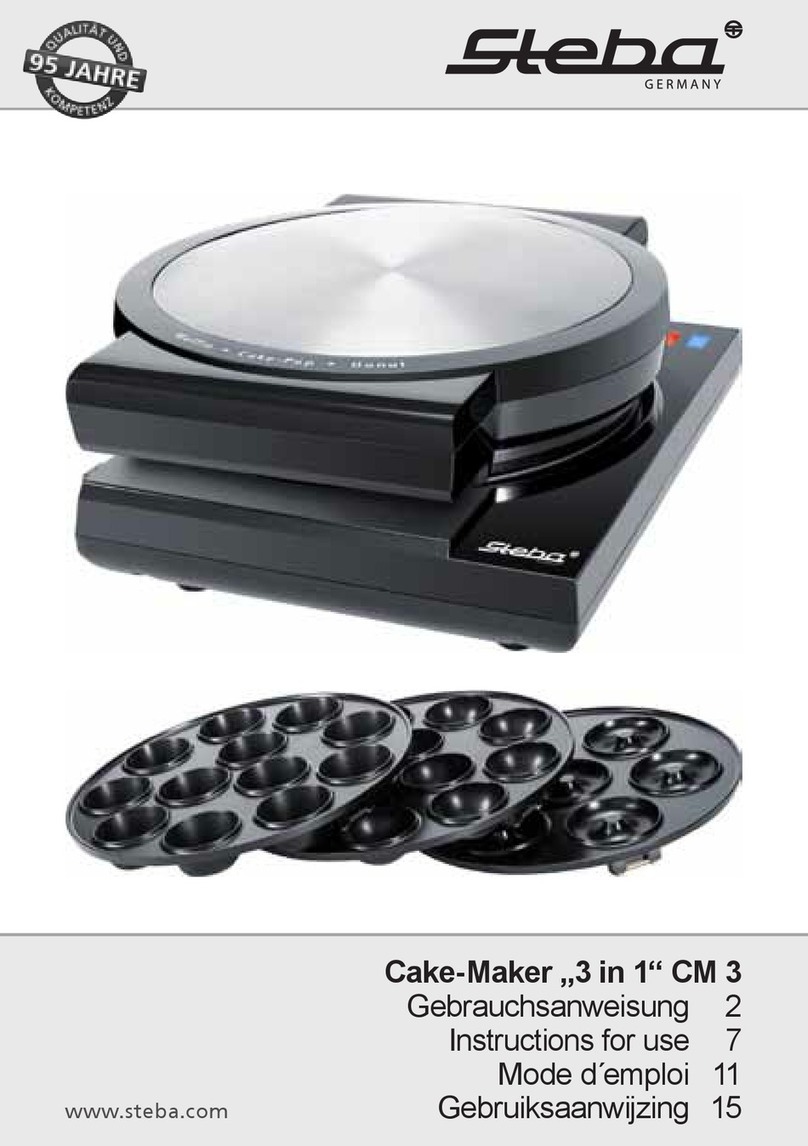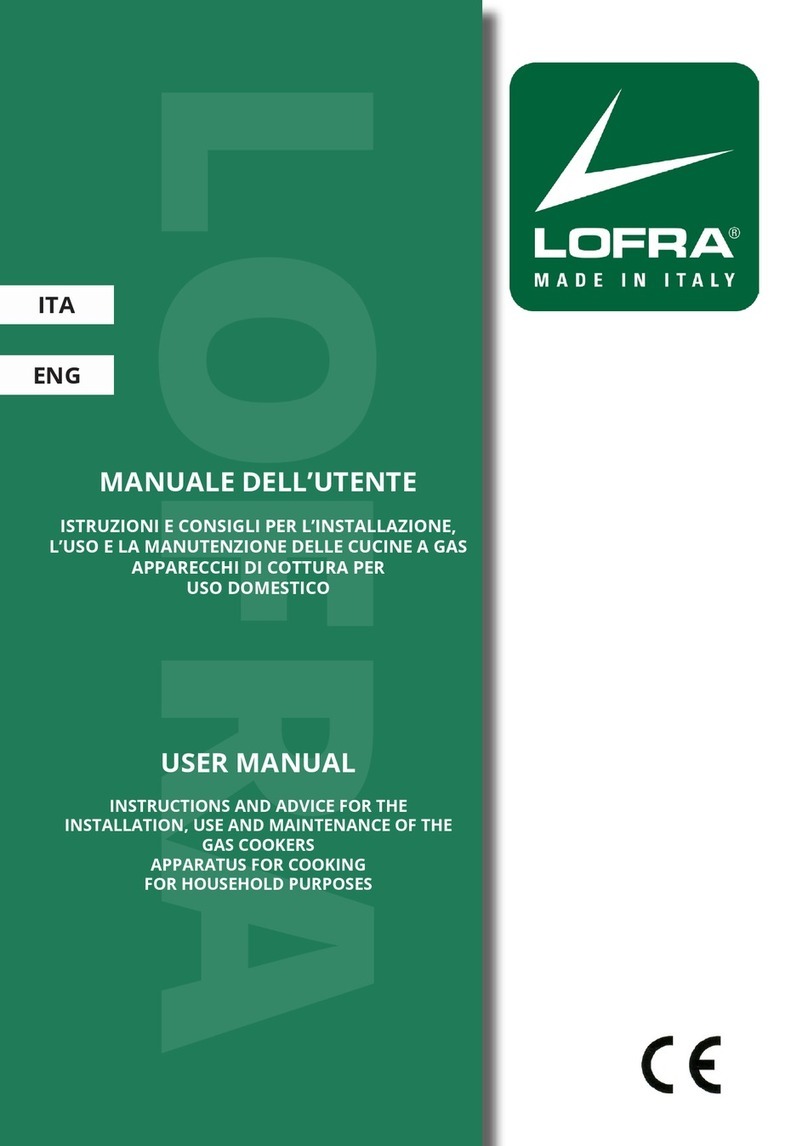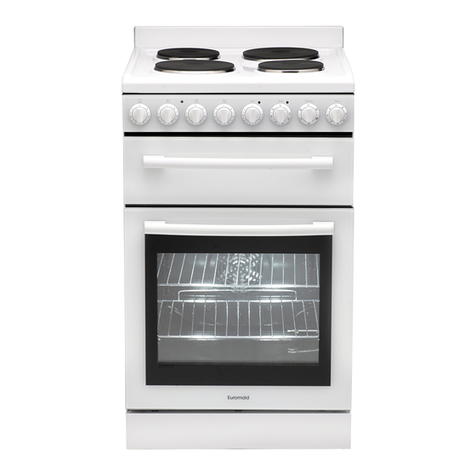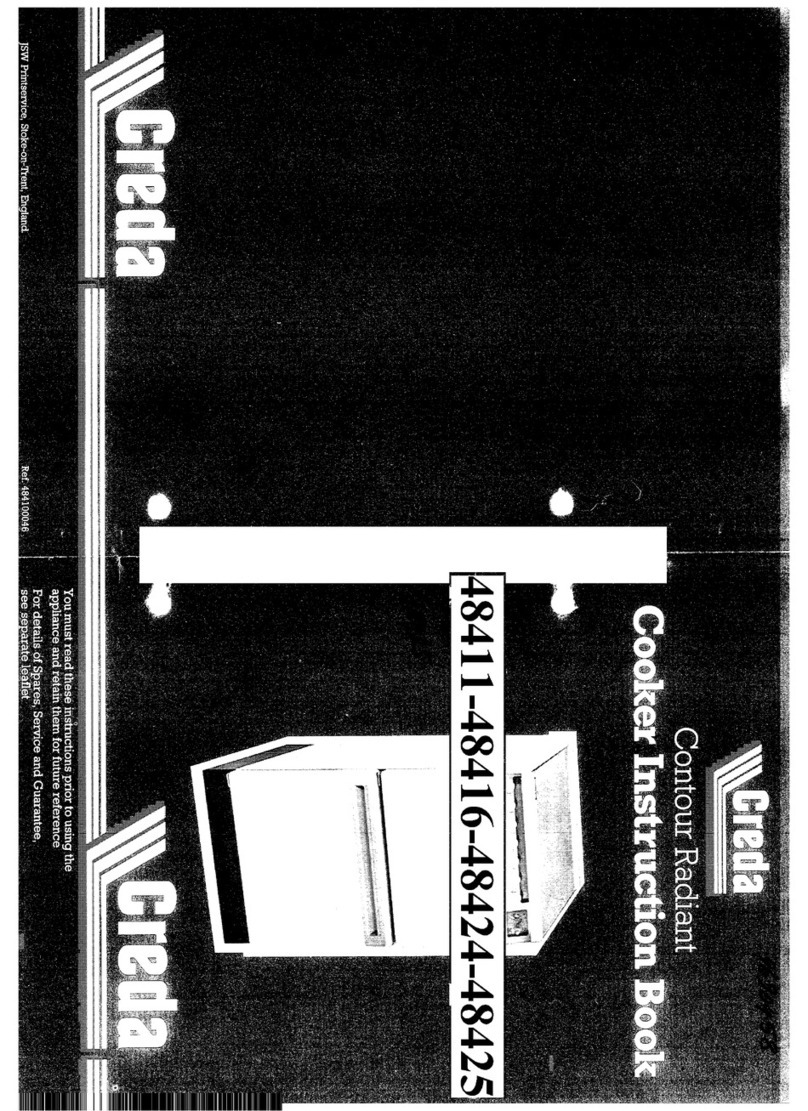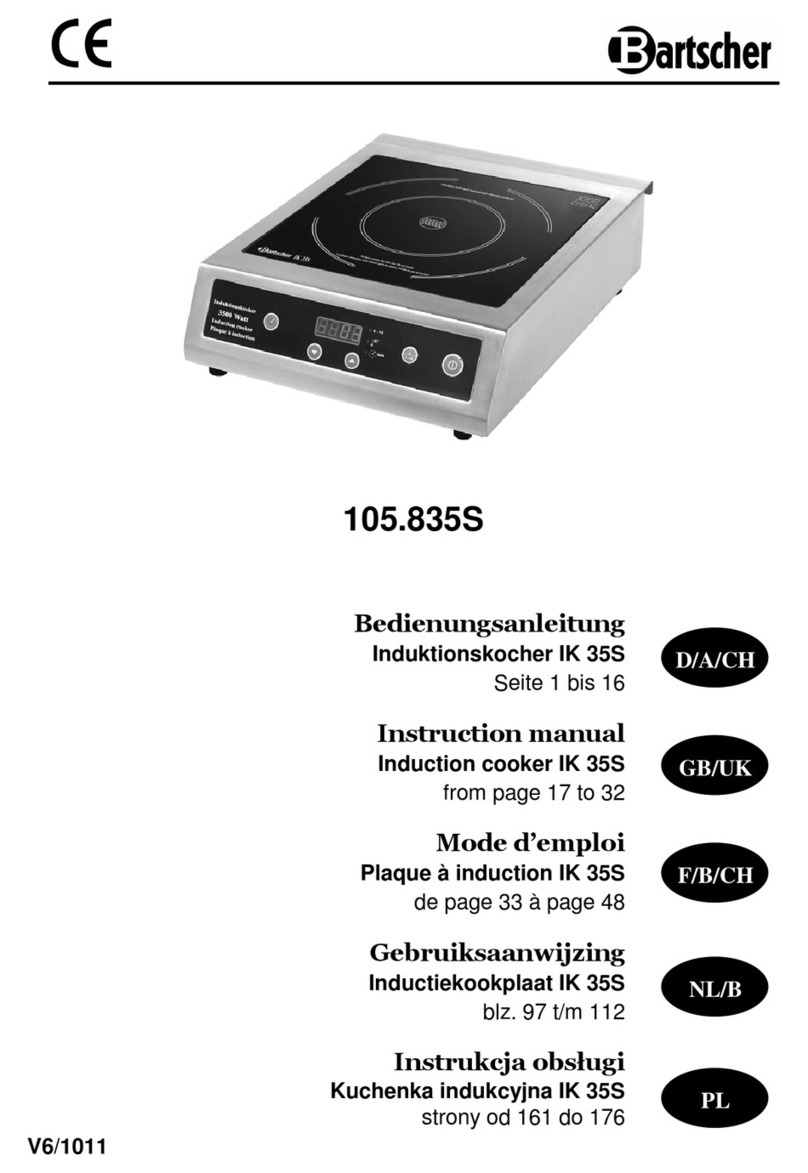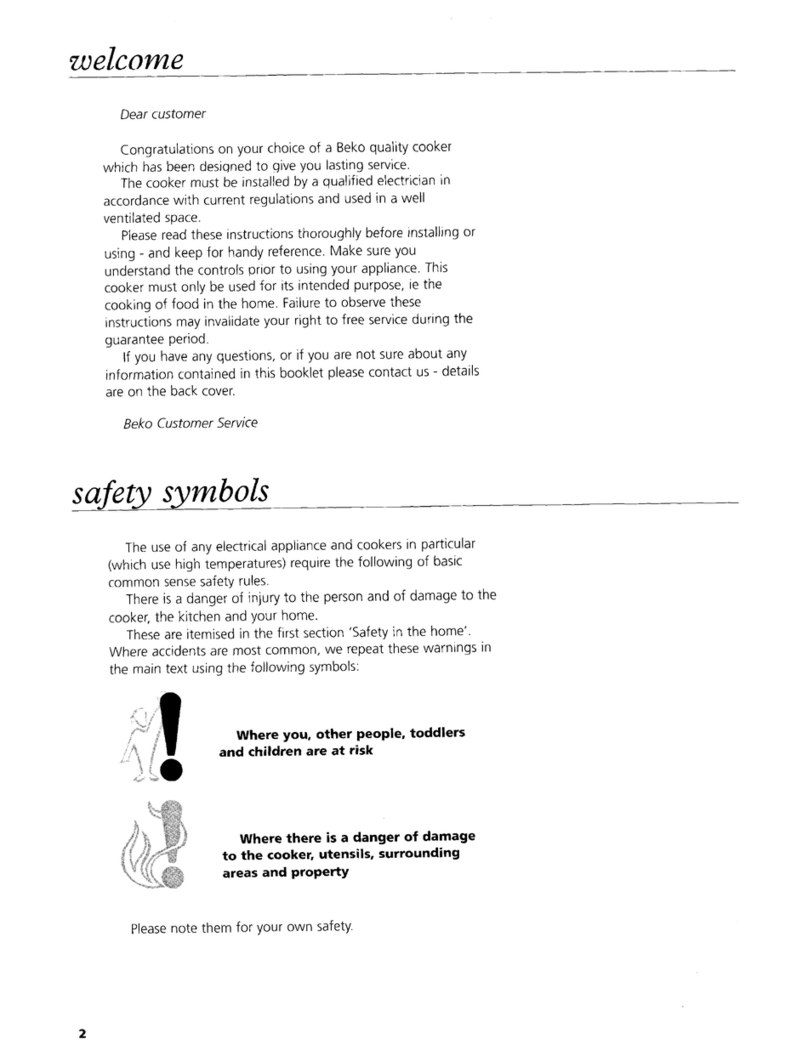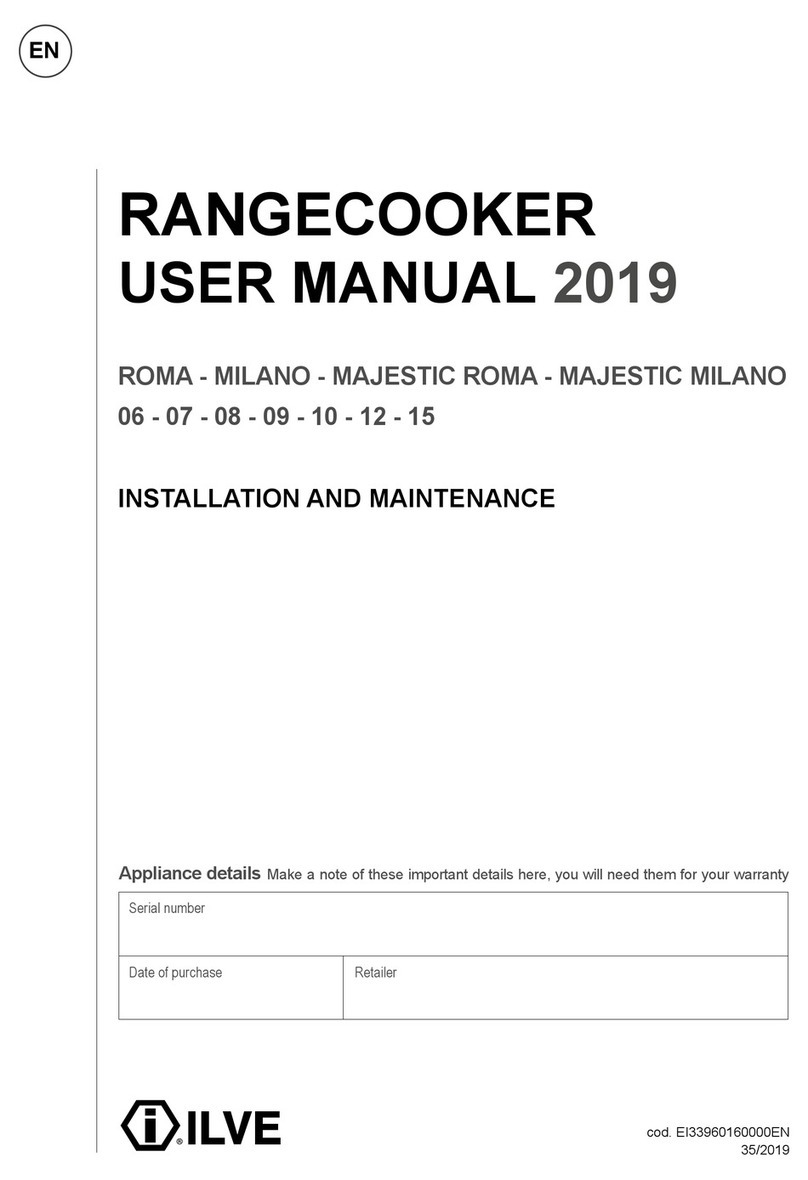de manincor F 450 Manual

WOOD FIRE COOKERS
User and maintenance handbook

de Manincor S.p.A.
2
CONTENTS
1. SAFETY RULES page 3
2. IDENTIFICATION OF THE APPLIANCE page 5
2.1 IDENTIFICATION PLATE
2.2 TABLE OF TECHNICAL SPECIFICATIONS
2.3 DESCRIPTION OF THE CLASSIC COOKER
2.4 DESCRIPTION OF THE DOMINO COOKER
2.5 DESCRIPTION OF THE ECO COOKER
3. INSTALLATION page 8
3.1 HANDLING AND INSTALLATION
3.2 DOMINO
- Inversion of the flue gas outlet
- Adjusting the fire door lock
3.3 THE FLUE SYSTEM
- Flue pipe characteristics
- Flue pipe dimensions
- Connection to the flue pipe
4. INSTRUCTIONS ON USE page 12
4.1 WOOD-FIRED COOKER OPERATING INSTRUCTIONS
- The fuel
- Initial start-up
- Operating the wood-fired cooker
- Combustion speed
4.2 USING THE OVEN
4.3 USEFUL NOTES
- Heat diffuser plate
- Hearth grill
- Internal ash drawer
4.4 TROUBLESHOOTING
5. MAINTENANCE page 17
5.1 ROUTINE CLEANING AND CHECKS
5.2 MAINTENANCE OF THE COOKING PLATE
5.3 STRUCTURE AND OTHER EXTERNAL PARTS
6. GUARANTEE page 18

de Manincor S.p.A.
3
WOOD-FIRED COOKERS
Rules and/or instructions marked with this symbol are associated with
safety!
1. SAFETY RULES
The following rules and precautions help you to avoid the risks associated with use of this
appliance:
The appliance must be installed according to the rules in section 4.2 of this handbook;
Installation must be carried out in conformity with all rules at the workplace, as well as
with all domestic and European regulations;
Make sure the flue is suitable before connecting the cooker to it;
It is strictly forbidden to use chemical products for lighting the cooker –such as alcohol,
oil, petrol, etc.
Do not put in too much fuel as this can produce excessive heat and overheat the
appliance, causing potential damage;
The cooking plate can reach high temperatures of up to around 400 °C; be careful
therefore and do not touch it without appropriate protection –the same applies to the
other components such as the fire chamber and oven doors and their respective handles,
glass surfaces and the flue pipe;
Do not put any plastic bottles or spray cans on top or in the immediate vicinity of the
appliance (risk of fire and explosion);
Warn children of the risks and keep them away from the stove when it is in operation;
Place sheet metal protection on the floor under the fill opening, especially if the floor is
made of lino or wood;
Use only natural fuel such as: wood, blocks of compressed wood and lignite briquettes;
Do not burn any plastics, treated wood (e.g. chipboard) or textiles;
Clean the flue on a regular basis.
2. IDENTIFICATION OF THE APPLIANCE
2.1 IDENTIFICATION PLATE
There is an identification plate at the back of the appliance that indicates model, serial
number and date of manufacture.

de Manincor S.p.A.
4
2.2 TABLE OF TECHNICAL SPECIFICATIONS
CLASSIC
Technical Specifications
um
F 450
F 6000
F 800
F 900
External dimensions: l x d x h
cm
45x60x86
60x60x86
80x60x86
90x60x86/51
Heating plate l x d
cm
31x45
48x45
68x45
74x45
Net weight/with packaging
kg
115/125
170/180
180/200
180/200
Required flue depression
mbar
0.12
0.12
0.12
0.12
Nominal thermal output
kW
5
7.5
9.5
9.5
Co at 13% O²
%
0.21
0.21
0.22
0.22
Mean flue gas temperature
°C
262
262
303
241
Flue gas mass flow
g/s
12
11.8
11.6
10.3
Efficiency
70%
75.5%
73%
73%
DOMINO
Technical Specifications
um
D6
D6maxi
D8
D8maxi
External dimensions l x d x h
cm
60x60x85
60x60x85
80x60x85
80x60x85
Heating plate l x d
cm
45x48
45x48
66x48
66x48
Net weight/with packaging
kg
180/195
180/195
195/215
195/215
Required flue depression
mbar
0.12
0.12
0.12
0.12
Nominal thermal output
KW
7.5
7.5
10
10
Co at 13% O²
%
0.21
0.21
0.12
0.12
Mean flue gas temperature
°C
262
262
293
271
Flue gas mass flow
g/s
8.5
8.5
14.9
14.1
Efficiency
75.5%
75.5%
72.5%
72.5%
Cucine a legna
Caratteristiche Tecniche
um
E60
E80
E90
A900
External dimensions l x p x h
cm
60x60x86
80x60x86
90x60x86
90x60x86
Heating plates l x p
cm
48x45
68x45
74x45
74x45
Net weight/with packaging
kg
130/140
165/180
175/190
180/200
Required flue depression
mbar
0.12
0.12
0.12
0.12
Nominal thermal output
KW
6
7
8
8
Co at 13% O²
%
0.15
0.13
0.13
0.13
Mean flue gas temperature
°C
263
228
228
228
Flue gas mass flow
g/s
10.9
13.7
13.7
13.7
Efficiency
70%
71%
71%
71%
Internal diameter of test flue: D = 150mm;

c
i
d
a
f
h
e
g
k
b
a
j
g
i
i
i
i
2.3 DESCRIPTION OF THE CLASSIC COOKER
a) Iron cooking plate
b) Set of cooking rings or high yield disk, available on request
c) Height-adjustable hearth grille for F800/900/910 and rustic series
d) Oven with tempered glass window, thermometer
e) Starter for starting the cooker up from scratch
f) Lever for primary air adjustment, situated under the ash drawer
g) Lever for secondary air adjustment, situated under the fire drawer
h) Access for cleaning the flue gas circuit
i) Wood drawer
j) Cover on the flue gas outlet at side (specific version)
k) Ash drawer
l) Removable plinth cover
m) Fixed plinth cover
2.4 DESCRIPTION OF THE DOMINO COOKER
a) Iron cooking plate
b) Set of cooking rings or high yield disk, available on request
c) Iron fitting for flue gas connection
d) Oven with tempered glass window, thermometer, grill pan and grill
e) Oven light switch
f) Oven valve for discharging humidity
g) Lever for primary air adjustment, situated under the door of the combustion chamber
h) Starter for starting the cooker up from scratch
i) Access for cleaning the flue gas circuit
j) Wood drawer
k) Ash drawer
F900/F800
F6000
a
b
k
d
g
f
i
c
l
f
g
e
m
e
h
DOMINO6
DOMINO8

de Manincor S.p.A.
6
c
a
g
i
d
g
b
a
e
h
f
2.5 DESCRIPTION OF THE ECO COOKER
a) Iron cooking plate
b) Set of cooking rings or high yield disk, available on request
c) Oven with tempered glass window, thermometer, pan and grill
d) Oven light switch
e) Starter for starting the cooker up from scratch
f) Access for cleaning the flue gas circuit
g) Lever for primary air adjustment
h) Wood drawer
i) Ash drawer
2.4 DESCRIPTION OF THE A900 COOKER
a) Iron cooking plate
b) Set of cooking rings or high yield disk, available on request
c) Oven with tempered glass window, thermometer, pan and grill
d) Starter for starting the cooker up from scratch
e) Lever for primary air adjustment
f) Access for cleaning the flue gas circuit
g) Wood drawer
h) Ash drawer
i) Removable plinth cover
l) Oven light switch
ACCESSORIES PROVIDED
The cooker comes with these accessories:
This handbook and guarantee
Grill handle (model F800, F900)
Bar for moving the rings
Baking pan
Oven glove
E60
E90-E80
a
h
c
g
f
i
A900
d
e
b
l

de Manincor S.p.A.
7
3. INSTALLATION
3.1 HANDLING AND INSTALLATION
Make sure the flue is suitable before connecting the cooker to it (see chapter 3.2).
NOTES:
The appliance must be installed on a floor of sufficient weight-bearing capacity. If it is not
satisfactory, take the appropriate measures (e.g. weight distribution plate);
The appliance must be installed to ensure easy access for cleaning the same appliance,
the gas discharge pipes and flue pipe.
The appliance cannot be connected to a shared flue pipe.
Air extraction devices must not be used in the same room as the appliance, unless there
is a suitable air ventilation system.
Install the appliance in a room of a size suited to its potential and that is sufficiently
ventilated (window or specific air vent).
WARNING: do not lift the cooked by its handrail
To move the cooker, remove the plinth cover if present.
Wood cookers have removable plinth covers. The F600 and DOMINO wood cookers however
have fixed plinth covers.
Safety distances from inflammable materials:
- Distance between cooker and wall at side: L = 600mm;
- Distance between cooker and wall at back: D = 200mm + reflective steel plate of 20/10
- Distance above floor: F = 0
- Distance at front from inflammable material: R > 60cm;
Safety clearances from inflammable materials: built-in furniture side
- Minimum distance between cooker and built-in inflammable furnitures C= 25 mm

de Manincor S.p.A.
8
The cooker must be installed in a room of a size suited to its potential and that is
sufficiently ventilated (window or specific air vent).
Burning 2 kg of wood requires the reintegration of around 30 cubic metres of air. Failing this,
the environmental conditions will not be suitable for people due to impoverished oxygen
supply and the wood will not burn well due to a lack of combustion air.
CLASSICA PRODUCTS
Place the cooker on the floor, pull out the wood
drawer, remove the 4 screws on the plinth cover
(2 on each side), remove the plinth cover, install
the cooker in the required position, connect it to
the flue, and level the cooker by adjusting the feet
using a 4 mm allen wrench.
The F6000 has a sliding plinth cover.
To level the cooker, turn the four screws on the
outside; to move back the plinth undo the 4
screws on the inside, move the plinth and then
attach the same screws using a 6 mm allen
wrench.
The DOMINO and ECO cookers has a fixed plinth.
If the cooker is to be installed between other units, leave a gap of at least 2 mm on
each side as the cooker tends to expand with heat.
3.2 DOMINO PRODUCTS
Inversion of the flue gas outlet: from right-hand outlet to left-hand outlet
1. Remove the cooking plate, the ash drawer, the fender, the ash tray and iron grill in the
hearth
2. Remove the cover on the flue gas pass under the ash drawer; the 80 cm model has two-
on the left and right.
3. Remove the cap on the flue gas pass from its right-hand housing (at the side of the oven),
turn it 180° and place it in the left-hand housing.
4. Turn the starter from right to left: undo the knob, slide out the pin from the hinge and
remove the panel-valve; then remove the control rod.
Undo the M5 bolts on the cover of the left-hand flue’s starter and re-assemble on the right-
hand one. Use an 8 mm socket wrench and an 8 mm tubular spanner.
Remove the screw on the hole of the starter’s rod opposite the position of the removed rod.
5. Reassemble the starter’s components in order on the left-hand side
(NB: the flue gas outlet, flue gas pass cover and starter must be on the same side)
NOTE: to invert the top flue gas outlet
- domino6: you need to order the specific iron plate
- domino8: simply open the hole to be used and close the one on the opposite side
Adjusting the fire door lock
1. Use a Phillips screwdriver to undo the top and bottom screws
2. Use a 3 mm hexagonal allen wrench and:
- tighten to reduce play of the closure
- loosen to increase play of the closure
3. Re-attach the two screws

de Manincor S.p.A.
9
3.3 THE FLUE SYSTEM
FLUE PIPE CHARACTERISTICS
It is essential that the flue is suitable for the appliance to work correctly.
The flue system should be inspected by a technician experienced in flues before installing the
appliance, and then be checked at least once a year.
The flue pipe must conform to the regulations in force and be kept in perfect
condition.
Below are several instructions on fitting the flue pipe. Non-compliance with these could
compromise the appliance’s yield and cause problems with combustion:
a) Its height must not be less than 4/5 linear metres from the connection to the stove
to the base of the chimney pot; the flue can be narrower if its height is any greater.
b) It must be properly sealed and insulated; make sure the inspection panels close properly
and that there are no cracks on any part of the flue pipe.
c) The inside of the pipe must be smooth and the same width all the way up.
d) The flue must be as straight as possible and the chimney pot must be in a suitable
position and at an appropriate pitch, as indicated in the diagrams and examples below.
e) The chimney pot must be double the width of the flue pipe.

de Manincor S.p.A.
10
CROSS-SECTION: the flue pipe’s cross-section depends on the height of the flue and the
thermal power of the installed cooker.
To ensure the optimal yield of our cookers we recommend you use circular flue pipe with
smooth interior lining and of the same length all the way up.
INSULATION: flue draught pressure also depends on the difference in the temperature of the
hot flue gases and that of the air outside.
The flue pipe must be insulated to restrict absorption of heat into the walls and therefore
avoid condensation, which can cause tarry residues. Use only suitable heat- and corrosion-
resistant materials conforming to building and fire-prevention regulations. You should not use
flue pipes comprising simple or flexible metal tubes, cement tubes for vents, etc.
DEPRESSION: the optimal depression (flue draught pressure) for de Manincor’s cookers is
0.12 mbar.
At a depression below 0.12 mbar, the fire will burn too slowly and form carbon residue
excessive gases. If instead depression is any greater, combustion will be too fast and not
transmit as much heat to the boiler and heating plate, and will require more attention.
FLUE PIPE DIMENSIONS
The figures in the table are valid for stainless steel tubes with 30 mm insulation and stainless
steel plating.
Increase the cross-section by 10% for every 500 metres above sea level.
The cross-section may be changed by -10% to +30%.
Brick or refractory flue pipes do not ensure as good a draught pressure as stainless steel
ones. Circular pipes should be no less than 15 cm in diameter and square ones should
measure a minimum of 15 x 15 cm. If this is not feasible you should contact a flue specialist.
WOOD-BURNING COOKER
COOKER POWER
[Kw/H]
QUANTITY OF WOOD
BURNED (beech)
[kg/h]
FLUE PIPE SHAPE AND
CROSS-SECTION
LENGTH OF THE FLUE PIPE [metres]
4
5
6
7
8
10 –5
2.5
Circle diameter [cm]
15
14
14
13
12
Square side x side [cm]
14
13
12
12
11
RECOMMENDED SOLUTION

de Manincor S.p.A.
11
CONNECTION TO THE FLUE PIPE
Each cooker should have its own flue pipe. Do not use the same flue pipe for more
than one appliance.
The cooker should be connected to the flue pipe avoiding as far as possible any bends,
diversions and downward or horizontal sections (if these are unavoidable, the gradient should
be 2-3 cm per metre).
Connecting pipes must be perfectly sealed to each other and to the stove and flue pipe.
These precautions must be taken:
a) Use a seal to avoid infiltration of air into the flue
b) The pipe must not be narrower at the end
c) The end of the pipe must not protrude into the flue

de Manincor S.p.A.
12
4. INSTRUCTIONS ON USE
INITIAL NOTES
Do not use the appliance as an incinerator or in any way for which it was not intended.
Do not use fuel other than that recommended.
Do not burn any plastics or treated wood (such as chipboard) or textiles.
Do not use liquid fuel.
The appliance, especially its outer surfaces, can become extremely hot to the touch when
in use; handle with care to avoid burning yourself.
Do not put any plastic bottles or spray cans on top or in the immediate vicinity of the
appliance (risk of fire and explosion);
Warn children of the risks and keep them away from the stove when it is in operation;
Do not make any unauthorized changes to the appliance.
Do not put in too much fuel as this can produce excessive heat and overheat the
appliance, causing potential damage;
Use only original spare parts approved by the manufacturer.
WHAT TO DO IN THE EVENT OF A FIRE IN THE FLUE PIPE
The use of damp and inappropriate fuel or operating the stove at too low a capacity can
cause easily inflammable substances, such as and soot, to accumulate in the flue pipe. This
can in the long term be a potential cause of fire in the flue pipe!
In the event of this happening:
Shut off the flow of primary and secondary air
Make sure everybody leaves the apartment or house
Call the fire brigade (telephone number: 115 in Italy)
FUEL
The appliance is designed for burning solid fuel: wood, blocks of compressed wood and lignite
briquettes. We recommend you use reasonably small pieces of wood that have been
seasoned for at least two years in a ventilated and covered area. They should ideally
measure 6-10 cm in diameter and 25-30 cm in length.
Dry wood ensures minimal gas emissions and the easier it is to burn, the less gas and soot it
will produce. We advise you bring wood into the house a few days before burning it so the
heat in the home will dry it out more quickly.
INITIAL USE
The flue system should be inspected by a technician experienced in flues before installing the
appliance, and then be checked at least once a year.
Check the following before lighting the wood-fired stove:
Check the grill is in its correct position in the hearth: the narrow end of the slits
should face upwards.
Check the combustion chamber is clean.
Check the ash drawer is empty.
4.1 WOOD-FIRED COOKER OPERATING INSTRUCTIONS

de Manincor S.p.A.
13
WARNING: when you use the cooker for the first time, it is normal for condensation to form
due to humidity in the refractory materials. Start with a small fire and keep the fill opening
and ash drawer ajar for a few hours to encourage evaporation.
If the stove has not been used for a long time, start the initial fire with just
newspaper and then kindling.
INITIAL START-UP
After putting dry kindling into the hearth for your initial fire, continue as follows:
Pull the starter to let the gases flow directly into the flue pipe
Fully open the primary air source by turning the lever all the way round to the right
Load the kindling and igniting material: balls of newspaper or other small dry fuel
Light the fire
When the fuel is burning brightly and the flue has heated up sufficiently (this may take 30
minutes or more), close the starter and put in some larger pieces of wood
WARNING: (hearth with glass door) to prevent the glass from getting dirty leave the
door ajar with the handle in closed position (see photo 5) and wait for ten minutes or so
for the glass to heat up and thereby avoid condensation on the inside due to the
difference in the temperature of the flames and the internal surface of the glass.
DO NOT USE ALCOHOL OTHER FUEL TO ENCOURAGE OR SPEED UP THE FIRE.
OPERATING THE WOOD-FIRED COOKER
LIGHTING THE FIRE IS THE MOST CRITICAL PHASE FOR GENERATING FLUE
DRAUGHT PRESSURE; AFTER THIS YOU SHOULD KEEP MONITORING THE FIRE.
It is possible that the wood will not catch fire and that your initial fire might go out after
a few minutes. This is because the flue pipe is cold and there is insufficient flue draught
pressure. Start your fire again using easily combustible material: thin dry sticks, shrubs, pine
cones and newspaper are ideal for this first phase.
When the wood has caught fire, regulate the primary air supply by turning the lever
under the ash drawer or under the hearth door (F6000 and Atmosfera) or turning the
thermostatic control (ECO line), so that the logs burn well with tall flames. Avoid too great a
flue draught pressure but also don’t let combustion get too slow as this can result in the
deposit of soot in the stove. Try not to open the stove door too often to add wood.
Make sure there is always a good bed of glowing embers at the bottom of the stove
and add wood as soon as the previous logs have turned into embers: the bed of embers
maintains the temperature required for igniting more wood and ensures correct combustion.
Always arrange the logs crosswise so that air can pass between them and ensure good
oxygenation. Try and keep the flames burning; most heat is generated by the combustion of
the gases. If the flames die down completely, unburned gases are produced that waste
energy and pollute.
COMBUSTION SPEED

de Manincor S.p.A.
14
You can adjust the air control devices and grill to increase or decrease combustion speed and
therefore the heating or cooking temperature:
- Fast combustion: primary air lever “g” open (fully to right) –secondary air lever “f” open
(fully to right) CLOSED OPEN
-Slow combustion: primary air lever “g” closed (fully to left) – secondary air lever “f” open
(fully to right) CLOSED OPEN (only F6000 secondary air OPEN CLOSED )
For DOMINO, ECO and ATMOSFERA models: operate only on primary air control.
IMPORTANT: during fast combustion make sure there is no more than 3 kg of
wood in the stove at all times. A greater amount of fuel requires you to reduce the
combustion speed proportionally by closing the primary air control and opening the
secondary one. Adding more fuel without changing the combustion speed will produce
thermal power greater than the cooker –environment exchange capacity. This will not only
waste fuel but could also damage and deform the appliance.
Avoid overloading the appliance. A relatively small and well oxygenated fire will burn
better and produce more heat than a large stack of wood blocking the hearth.
The ideal load for efficient and clean combustion is 2 kg of wood per hour.
WARNING: Thermal shock caused by a sudden increase in temperature can form small
cracks in the refractory bricks. These cracks will not compromise the structure and resistance
of the bricks or cooker in any way.
When combustion has ended close the primary air lever and any secondary air slits to
prevent the heat in the stove escapes with the flow of air in the flue.
Lack of flue draught pressure. A column of cold air could form in the flue pipe for a variety
of reasons. These could be low atmospheric pressure, humidity, strong winds or depression in
the house (e.g. if the hood above your kitchen stove is switched on).
In the event of low atmospheric pressure or rain, the flue draught pressure will not be
nearly as good as on a clear day or during a cold, dry winter. Humidity can also form in the
flue pipe if the stove is not used for a long period of time. It is worth keeping the stove’s
doors ajar to let air circulate in the flue pipe.
4.2 USING THE OVEN
The oven always needs to be pre-heated for cooking. Leave the fire to burn for about an hour
with the primary air valve open and then wait for about ten minutes after the flames have
died down in the combustion chamber.
For baking, keep the temperature constant by adding thin wood to the stove measuring
about 3 cm in diameter and weighing 600 to 800 grams, for about 40 minutes, at a rate of
one or two pieces every ten minutes.
Add a suitable amount of fuel to the combustion chamber, open the primary air lever and
close the secondary air lever to obtain the required temperature.
DOMINO MODELS: Oven chamber steam release valve
On the right-hand side of the oven is a valve for releasing any steam generated during the
cooking phase. To operate the valve, simply turn it with the poker.

de Manincor S.p.A.
15
4.3 USEFUL NOTES
HEAT DIFFUSER PLATE
The iron heat diffuser plate must never become incandescent. Always use receptacles with
flat heavy bases (for maintenance see chapter 5.2)
HEARTH GRILL
Poking the embers on the iron grille in the combustion chamber will make the ash fall
through into the ash drawer below. This clears the way for the supply of primary air to the
combustion chamber –particularly important when starting up your fire.
The slits in the grill have two specific functions: they let combustion air pass through and, at
the same time, enable the disposal of the embers and ash.
The slits are wide enough to let through the ash and any dead embers; while the walls of the
slits are conical so as to not block the flow of air.
WARNING:
The grill must be positioned with the narrow side of its slits facing upwards.
INTERNAL ASH DRAWER
The ash drawer must be emptied on a regular basis to prevent the iron grill from
overheating.
There may still be some glowing embers in with the ash. Put these in a suitable metal
container.

de Manincor S.p.A.
16
4.4 TROUBLESHOOTING
Problem
Possible cause
The stove does not
work
It is not connected properly to the flue (see page 11, fig. 8)
The flue pipe does not conform (see fig. 8)
Other appliances are connected to the flue pipe
The hearth grill is the wrong way round
The hearth grill is blocked with ash
Smoke comes out of the
plate
No flue draught pressure
It is not connected properly to the flue (see fig. 8)
The starter and/or primary air valve is closed
The plate’s seals have come loose or are broken
Condensation in the
hearth
The wood is damp or not properly seasoned
The flue is too wide
Poor flue draught pressure
The fire lights with
difficulty
The starter is not fully open
The flue is cold (due to a long period of inactivity)
The oven does not get
sufficiently hot
Poor or insufficient flue draught pressure
The internal pipes are clogged
The starter is open
(Domino model only) Check the version of the flue
The various reasons the stove might not work properly
The flue pipe is at fault
Too short. The flue pipe stretches from the connection with the stove to the base of the
chimney pot.
If the flue pipe is too short, increasing its internal width will never compensate for the
reduction in height as that will only increase heat dispersion, lower the temperature of the
gases and potentially compromise flue draught pressure. You are better advised to use a flue
pipe of the correct width and increase its height by 1 or 2 metres to ensure decent flue
draught pressure.
Too long. This doesn’t generally affect flue draught pressure; however the flue pipe should be
well INSULATED to minimize heat dispersion.
Too wide. A flue pipe that is too wide will have a proportionally larger surface area that will
encourage the gases to cool down and therefore compromise flue draught pressure. One
option is to put a stainless steel pipe of suitable width inside the existing flue pipe and, after
connecting it to the stove, fill the gap between the two pipes with heat-resistant granular
insulation material (such as mineral perlite).
Too narrow. In this case you will not be able to exploit the stove’s potential. We can only
suggest that you reconstruct the flue pipe according to the required specifications.
Tight sections. Changes in the pipe’s width will cause a loss of flue draught pressure, slowing
down and potentially preventing the gases from leaving the flue.
Too many bends. Bends cause a loss of flue draught pressure, preventing the gases from
leaving the flue. For each bend you need to increase the height of the flue pipe by 50
centimetres so as to ensure optimal flue draught pressure.
Excessive deviations. Deviations affect the discharge of gases and should generally be
avoided.
Horizontal sections. These should be avoided or kept as short as possible and always at a
minimum gradient of 2 cm per metre. You are advised to assess the depression to guarantee
sufficient gas evacuation. The flue pipe should be increased in proportion to requirements.
Obstruction in the flue pipe. When the stove is not used for a long period of time, and
especially during the summer, you might find that birds, wasps or bees will nest in the
chimney pot; in which case you will have trouble lighting the stove again. Moreover, a poorly
or improperly made flue pipe may cause instances of crumbling plaster or cracks through
which air enters.

de Manincor S.p.A.
17
Cleaning the flue pipe. The flue pipe must be cleaned on an annual basis.
Air recovery
No air recovery. The stove can still be lit but soon burns up the available oxygen, reducing
combustion and causing the gases to build up and come out of the stove. The purity of the
ambient air is compromised as a result. In this case you definitely need an outside air vent.
Insufficient air recovery. If there is insufficient air recovery, combustion is poor and gases
will come out of the stove especially when you open the door to add more wood. If the stove
is installed in a room with double-framed doors or double-glazed windows, a suitable air vent
must be installed to ensure a good flow of air.
Other reasons
The position is too windy. You need to install a WINDPROOF chimney pot, otherwise any
change in the direction of the wind will compromise evacuation of the gases.
Presence of two flue pipes in the same room or in two adjacent rooms. The flue pipe with the
more powerful draught pressure will draw the gases from the one with the least powerful
one; as a result gases will come out of the stove with the poorer flue draught pressure.
Presence of a ventilating hood in the room. The ventilating hood is normally designed to
evacuate 300/400 cubic metres of air per hour. If there is insufficient air recovery, the air will
be retrieved by the stove causing smoke.
If you switch on the hood while the stove is in use, you must leave a window ajar for all the
time the ventilating hood is in operation.
Poor connections. Narrow sections, internal edges, imperfect joints and sharp bends might
accidentally be created when connecting the stove to the flue that could impede the
evacuation of the gases.
Uninsulated flue pipe. Gases passing through an uninsulated flue pipe will cool down and
compromise flue draught pressure. This causes atmospheric pollution, condensation and the
deposit of unburned products inside the pipe, affecting its efficiency.
Note: an uninsulated flue pipe causes the gases to cool down by 30 to 50°C per linear metre.
5 . MAINTENANCE
5.1 ROUTINE CLEANING AND CHECKS
The cooker is at its most efficient when all the surfaces and pipes the gases come in contact
with are kept perfectly clean. We advise regular maintenance by a qualified technician.
All maintenance and cleaning must only ever be carried out when the stove has fully cooled
down:
a) Remove the iron cooking plate and clean underneath thoroughly with a brush
b) Remove the pressurized door under the oven and use the small shovel to clean the flue-
ways, removing all the ash at the base
c) “Rustica” models: the pressurized door is removed by undoing its two retainer screws and
removing the oven door by opening and turning the safety catches 180°.
d) F6000 model: the flue gas pass under the oven is cleaned by removing the iron plate at
the base of the oven; be careful not to damage the fibre-glass seal when you put the
plate back again.
e) DOMINO models: the flue gas pass is cleaned as above; the part above the oven, instead,
is accessed by removing the closures under the ash drawer.
f) Clean all accessible areas.
Cleaning the ceramic glass of the combustion chamber’s door
Eliminate all traces of soot on the inner side of the ceramic glass using a soft cloth dampened
with a little clean ash, or with a suitable product in the event of stubborn traces of tar. Dry
well afterwards.
Clean the outer side of the ceramic glass with a damp cloth or, if necessary, with a little
neutral detergent. Dry well afterwards.

de Manincor S.p.A.
18
WARNING: when you are cleaning make sure you do not scratch the glass with rings or
other sharp objects.
DOMINO MODELS: Extract the oven door
a) Extract the door’s lock using a screwdriver if necessary
b) Turn the lock to its locking position
c) Close the door as far as the lock permits
d) Remove the door by lifting it and pulling it towards you
5.2 MAINTENANCE OF THE COOKING PLATE
When you first use the cooker, the iron plate will gradually change colour, starting with the
hottest part and, after a while, the colder parts. The plate eventually becomes all one colour.
Clean the heating plate with any type of detergent; then rinse it only if it is slightly warm so
that the humidity can evaporate naturally. Grease the entire plate with a cloth soaked in oil.
The heating plate is made of iron so prolonged contact with humidity will cause a thin layer of
rust to form on its surface. This can be removed as follows:
a) Rub the surface of the plate with 120 grit abrasive paper
b) Rub the surface with food oil or animal fat
c) Clean with a dry cloth
If you plan on not using the stove for a long period of time, it is a good idea to apply a new
layer of metal chrome (anti-rust) after the last use. Avoid cooking food directly on the plate
treated with metal chrome; if you do intend to cook food in this way, treat the plate instead
with a thin layer of food oil.
5.3 STRUCTURE AND OTHER EXTERNAL PARTS
The external parts in enamelled iron can be cleaned easily with water and neutral detergent.
Do not use aggressive or abrasive chemical products, especially on the smooth black glazed
surfaces and all the doors in the Arte series; any spills from pans or other should be cleaned
immediately.
The stainless steel parts should be cleaned when cold with neutral detergents or with vinegar
in the case of persistent stains. You must avoid using abrasive or acid products that
could damage the surface. Dry with a soft cloth, following the grain of the glazing.
6. GUARANTEE
MANUFACTURER’S DECLARATION
The de Manincor firm guarantees the appliance has passed all the in-house tests and
inspections and that is it therefore up to standard and without any manufacturing or material
defects.
GENERAL TERMS
The guarantee is valid for 2 years from the date of purchase. It applies only to the original
purchaser and is non-transferable. The guarantee covers original manufacturing defects and
applies to all of the product’s components.
To request a service under the terms of the guarantee, the customer must present a valid
proof of purchase (payment receipt, invoice, etc.), The proof of purchase must be kept in
good condition.
CONDITIONS
The de Manincor firm has the final say on what action should be taken to resolve any
problems under the terms of the guarantee.
Any defective parts that are replaced remain the property of the de Manincor firm.
The de Manincor has the final say on whether the service under the terms of the guarantee
should be done at the customer’s or its own premises.

de Manincor S.p.A.
19
For services offered under the guarantee, the customer is required to pay the minimum
charges according to the going rates. This is not the case however if the cooker is purchased
less than four months previously.
For repairs at de Manincor’s assistance centres, the customer is required to pay for the
transport costs.
IMPERFECTION OR DEFECT IN THE MATERIALS
Imperfection or defect in the materials must be signalled within 8 days since the customer
receives the products and anyway this implies only the obligation to replace what provided,
excluding any additional responsibility.
COMPONENTS NOT COVERED BY THE GUARANTEE
The following are not covered:
-Damage to parts attributable to negligence, carelessness or ineptitude, in particular
deterioration to the heating plate caused by improper or lack of maintenance.
-Damage to parts attributable to non-compliance with the instructions in this
handbook.
-Damage to parts attributable to transportation and failure to comply with some or all
domestic and local regulations.
-Damage to parts attributable to improper installation, insufficient capacity or faults
with the electrical, hydraulic and gas connections, and inefficiency of the flues and
discharge systems.
-The guarantee does not cover parts repaired by anyone not authorized by the de
Manincor firm.
-Technical services requested attributable to inefficiency of the flue and/or connecting
pipes are not covered by the guarantee and charged according to the going rates.
-Consumer parts like gaskets, glass, grids, refractory bricks, etc.
SERVICES AFTER THE GUARANTEE
Any services after the period of the guarantee or which do not fall under the terms of the
guarantee will be charged according to the going rates. In this case the cost of any
replacements will also be charged.
RESPONSIBILITY
The de Manincor firm cannot accept any liability for any direct or indirect harm or damage to
persons or objects caused by product defects if the rules set down by domestic or local law or
by this handbook have not been complied with.
COMPETENT COURT
Disputes and litigations are always settled at the court of Trento.
PRODUCT MODIFICATIONS
The characteristics of the products described in the catalogues and this user and
maintenance handbook are purely indicative. De Manincor aims to constantly improve upon
its products and therefore reserves the right to make any changes and improvements it
considers necessary without obligation for forewarning. De Manincor is also not obliged to
apply previous or current changes to products already or in the progress of being constructed
and assigned to customers.

de Manincor S.p.A.
20
Other manuals for F 450
1
This manual suits for next models
11
Table of contents
Other de manincor Cooker manuals
Popular Cooker manuals by other brands

Venini
Venini VEF91EG Installation, maintenance and use instructions
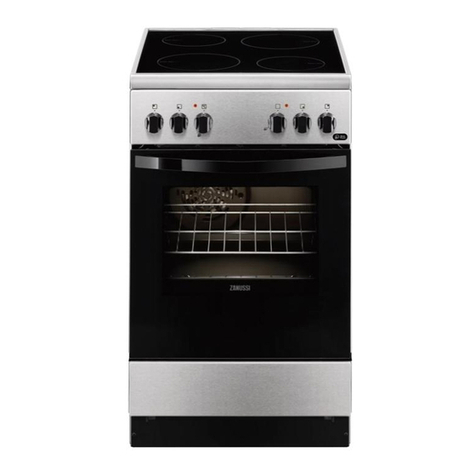
Zanussi
Zanussi ZCV55001XA user manual
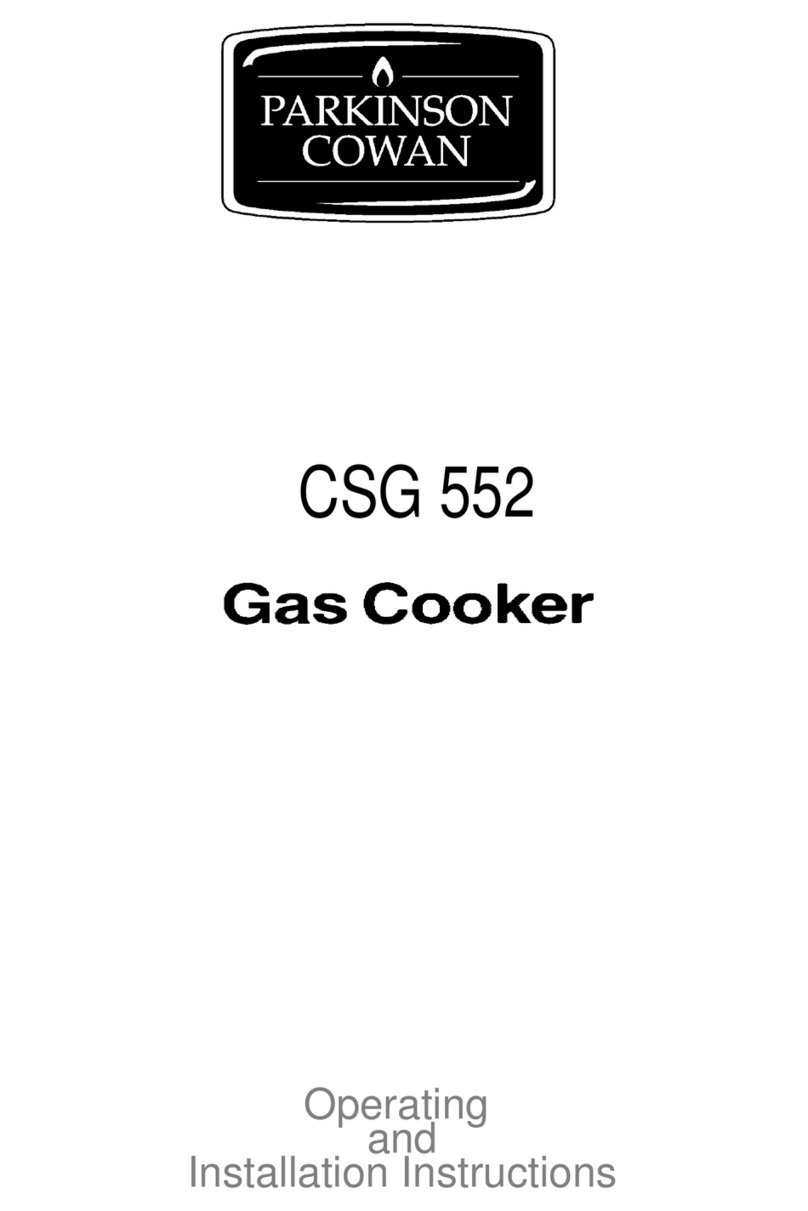
Parkinson Cowan
Parkinson Cowan CSG 552 Operating and installation instructions

Brinkmann
Brinkmann OUTDOOR GAS COOKER owner's manual
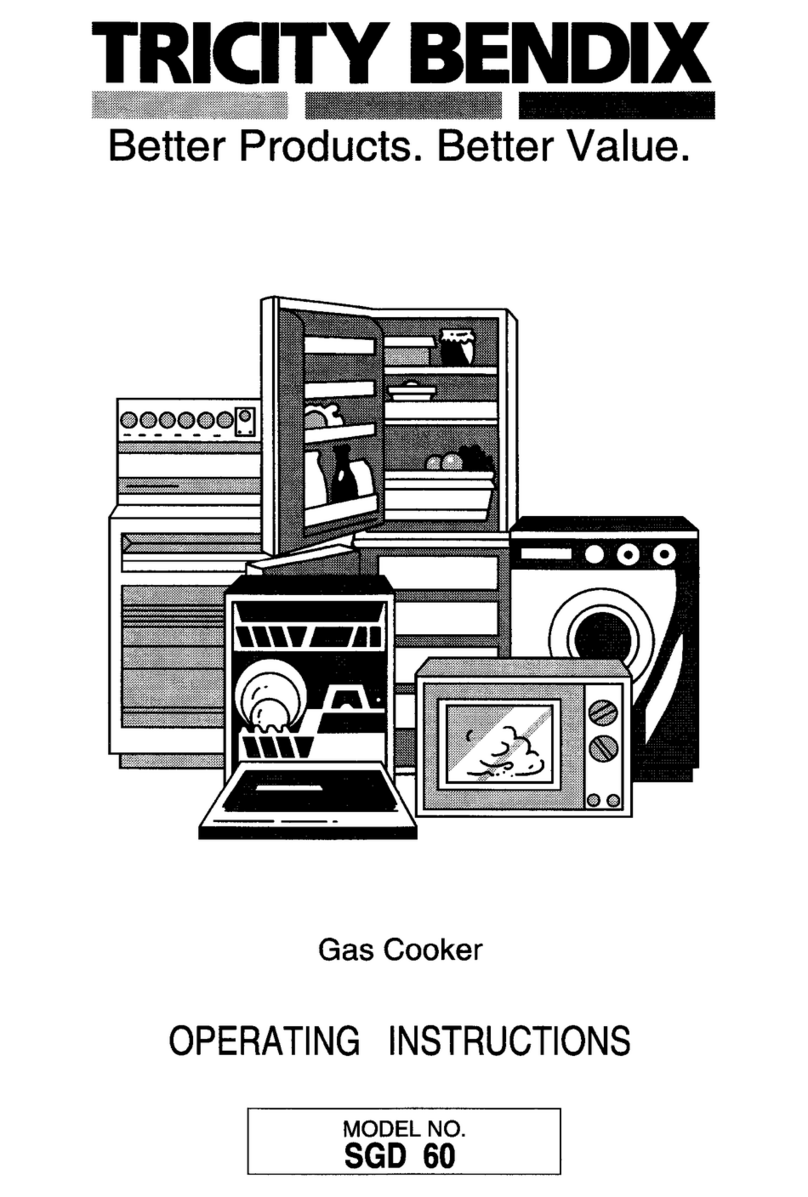
Tricity Bendix
Tricity Bendix SGD60 operating instructions
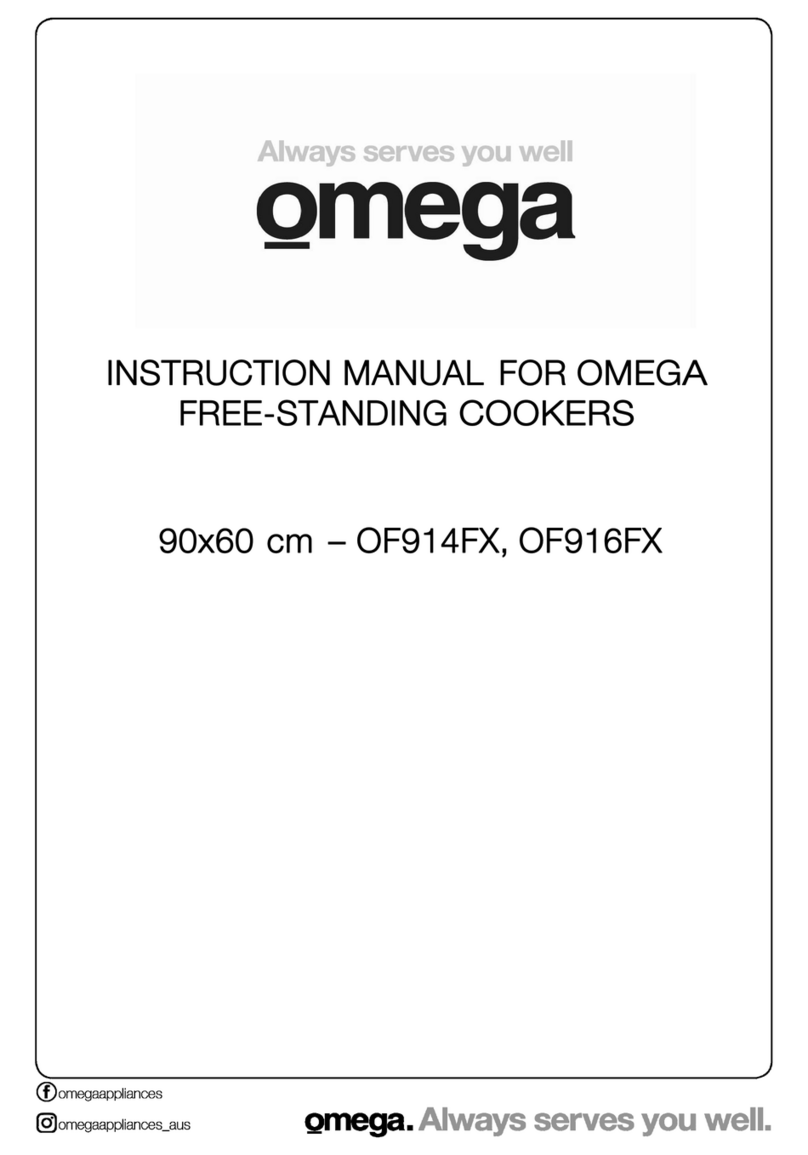
Omega
Omega OF914FX instruction manual
